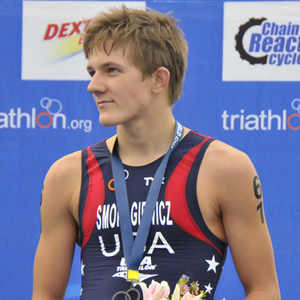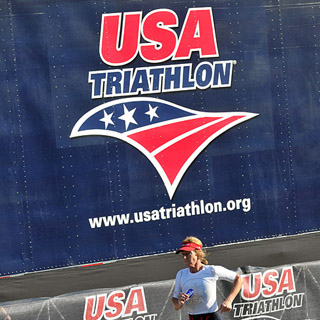Rapid City’s rapid tri talent
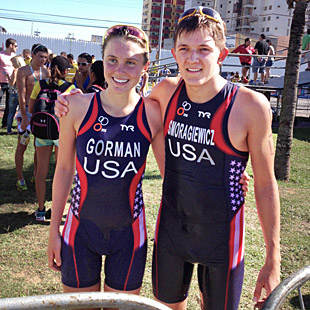
When Tony Smoragiewicz and Tamara Gorman won the junior elite gold medals at the Vila Velha PATCO Pan American Triathlon Championships in Brazil in June, it wasn’t too much of a stretch that two young U.S. triathletes were the 16-19 champions of two continents. The fact that they were both from South Dakota (population 833,000), no triathlon hotbed like California or Colorado, lengthened the odds considerably. But the fact that they both came from Rapid City, (pop. 69,000), a far cry from tri Meccas like San Diego or Boulder, had their coaches comparing them to the Brownlee brothers – albeit on a much more modest level.
But as for the odds, think about it. However astronomically talented the Brownlees are, they arose from a very close genetic makeup. Smoragiewicz and Gorman, who have been friends since they started club swimming with the Rapid City Racers at age 5 and 9 respectively, are not related.
While two budding triathlon stars do not make a trend, you wonder in your daydreams if Rapid City might become triathlon’s version of Bekoji, Ethiopia, a town of 20,000 that has bred multiple Olympic running champions. Is Tony and Tamara’s success just a coincidence of residence – or is there something in Rapid City’s water supply? The answer turns out to be a confluence of extraordinarily ordinary good influences – good families, good athletic genes, a small town big on Midwestern values that nurtures young athletes, a string of good local and national coaches, a watchful national triathlon organization on the lookout for young talent, and a beautiful Eden that beckons dreamers — runners and cyclists to its trails and roads in the Black Hills and swimmers to its lakes.
How good are these junior elites?
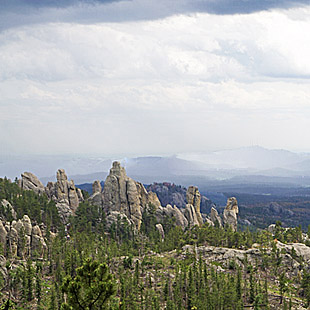
Neither Tony nor Tamara is a one-hit wonder. Both are ITU junior elite World Championship medalists – Smoragiewicz scored a bronze at age 17 in the September 11, 2011, race in Beijing, 38 seconds behind the gold of certified international star Lukas Verzbicas. To his credit he was 2 seconds faster on the Beijing run than the famed sub-4 minute high school miler.
At age 16, Gorman qualified for the ITU junior elite world championship by finishing 2nd by 4 seconds to Mexico’s Adriana Barazza at the 2012 Pan American Championship in Edmonton, Canada. At the 2012 junior elite women’s ITU World Championship in Auckland, New Zealand, she finished 6 seconds behind the gold medalist from Japan and 3 seconds behind the silver medalist from France – and thus became the first U.S. woman to earn a junior elite World Championship medal.
Both excelled in high school running. Racing for Rapid City Central High School, Tony won the mile, 2 mile and cross country South Dakota state titles as a junior and a senior and placed 2nd as a sophomore in all three events. During his high school career, his PR in the mile was 4:12 and 8:57 in the 2 mile. In his senior year, he placed 3rd at the Foot Locker cross country nationals and was ranked 3rd in a national high school endurance runner poll behind Verzbicas.
Racing as a freshman for Rapid City Stevens High School, Tamara won the 2010 South Dakota State Class AA cross country championship. She also placed 2nd in the mile and won the 3200 in the 2012 South Dakota High School state meet. Her PRs are 5:07 for the mile and 10:53 for the 3200 meters. And, as a junior, she finished just one place and 5 seconds out of qualifying for the Foot Locker Nationals in San Diego.
While Tony may have the edge in running, Tamara was a superior swimmer and that discipline remains her ace in the hole in international competition, as her 9:40 split at the 2012 Grand Final in Auckland was 49 seconds faster than the winner’s. While South Dakota does not have high school swimming teams, Gorman swam a 17:25 mile at the Speedo high school sectional meet against swimmers from 7 states. Tony, by contrast, built his aerobic base with swimming, but his best mark in the pool was a good but not great 5:08 in the 500 yard freestyle.
So what perfect storm of influences led these two kids to Rapid City to play out their athletic destinies?
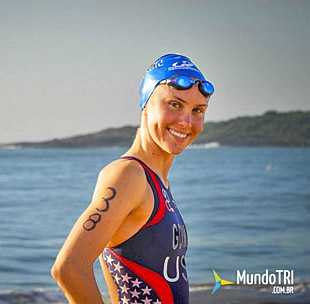
The families
Tony’s dad Jim grew up in Connecticut, swam for East Hartford high school and was an All-American swimmer at the University of Maine where he focused on backstroke and the Individual Medley. After graduation, Jim took up triathlon and competed in some of the first USTS Boston events. But his biggest athletic success was winning the 4-mile Doring Grace Fund Open Water Swim from Cape Cod to Martha’s Vineyard — and as far as he knows he still holds the record for that swim. After serving as the assistant swim coach at Syracuse University from 1982-1985, he was hired as head swim coach at the University of Toledo in Ohio, where he met wife-to-be Julie, who was working in public relations. Julie, says Tony, “never did sports, but she likes to take pictures” of her kids in their events. Jim Smoragiewicz served 10 years as Toledo’s swim coach until Julie, who grew up in Sioux Falls, South Dakota, was offered a job as Vice President of the South Dakota School of Mines in Rapid City. Whereupon the Smoragiewicz family packed up and moved when Tony was one year old.
Jim, according to Tony, “was a stay at home dad, taking care of my older brother Tyler and me.” Jim spent those first years guiding fishing trips and teaching fly typing classes at home before opening a store called Dakota Angler and Outfitters – and offering his expertise to high school swimmers and runners for free.
Tamara Gorman’s parents have lived virtually all their lives in Rapid City. “My dad Jeff works at GCC Dakota Cement and controls the drying process,” she says. “My mom Kelly is a teacher at Horace Mann Elementary School.” Unlike the Smoragiewiczes, both her parents had strong athletic inclinations. “My dad was a competitive swimmer through his childhood and into college, where he swam at the University of Minnesota,” she says. “My mom played soccer, softball and ran cross country in middle school.” Both were distinguished high school athletes. “My father was a state record holder in many events and placed ninth at 1982 YMCA Swimming Nationals in the 100 backstroke,” says Tamara. “He took to triathlons later in life. My mom played left halfback on the state soccer team.”
Early sports
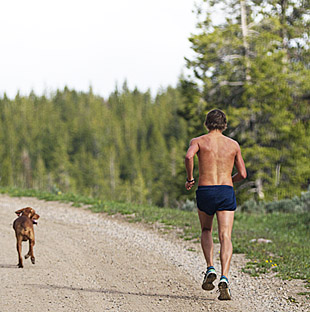
The families intersected at the Rapid City Racers club swimming team where Tamara started at the age of 5 and Tony joined two years later at the age of 9. “I enjoyed swimming but it was not what I really liked to do,” recalls Tony. “But because my dad was a big swimmer in high school and college, he pushed my older brother Tyler and me to do it. Looking back, I am really happy I did it. I wasn't that good, but it really gave me a big aerobic base.”
Tamara did not have to be pushed to start swimming and running. “I joined the Racers because of my brother Brian did it and I also ran in elementary school with a running club,” says Tamara. Their parents truly nourished both Tamara and her brother’s athletic endeavors. “When my brother and I were just in elementary school, we would be traveling all over the country to race in swim meets,’ says Tamara. “Mom and dad would make each trip into a mini vacation were we would not only compete but also do fun activities while on the trip.”
While they continued swimming and running, Tony and Tamara both took to triathlon just before their teens. In 2006 at age 12, Tony signed up to run on a relay team at the Rapid City Triathlon. “But when the biker couldn’t do it at the last minute, Dad said ‘Hey how about you do the whole thing?’ So I did the whole race and enjoyed it.”
Tamara’s older brother Bryan did a kid’s triathlon about the same time. “I thought it was kind of cool, but I didn’t race one until I was 13,” she said. Once Tamara started, she scored back-to-back wins at USA Triathlon Youth (13-15) Nationals in 2010 and 2011. “I just fell in love with the sport,” she said. “It’s hard, but it’s so fun.”
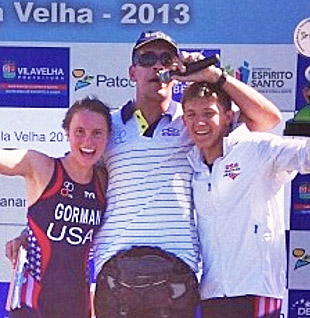
The USAT Connection
Jenny Weber, coach of the Z3 Junior Development Team based in West Des Moines, Iowa and a part of USAT’s Midwest talent search pipeline, received an email from USA Triathlon Athlete Development Coordinator Steve Kelley in the Fall of 2010. “Steve told me that high school freshman Tamara Gorman won her state championship in cross country and she was someone to watch in your region,” recalled Weber. “Not 24 hours later, I was on the phone to Tony’s dad Jim Smoragiewicz, who sent out a request for a small travel scholarship for his son in the Midwest region,” said Weber. “In that first call, Jim said ‘Do you know Tamara Gorman?’ ‘Funny you would say that, USAT just sent me an email about her cross country results.’
Tony plunged into triathlon two years before Tamara and was already a ranked youth and junior triathlete with little specific triathlon coaching. A year after his tri baptism, he signed up for an independent triathlon camp in Colorado Springs which offered a race afterwards. “I didn't finish very well after crashing on the bike — I hit a cyclist with my front tire,” he recalls.
By 2008, however, Tony was 14 and truly on his way. He placed 2nd at the USAT Youth Elite Nationals in Colorado Springs where the distances were 375 meter swim, 10k bike and 2.5k run — and might have done better if not for a crucial mistake.
“I caught Josh Kanute and Hunter Hunnicutt by a couple of seconds on the run,” recalled Tony. “I was running up a hill on a short out-and-back where the cones were two feet apart. Totally my fault for not scouting the course. I didn’t see the next cone which was 50 yards away and I turned too soon. When I saw Josh and Hunter running past where I turned, I realized my mistake and ran back after them. That cost me just under 10 seconds and I lost by 2 seconds.”
After that race, Smoragiewicz talked to USA Triathlon’s High Performance director Andy Schmitz and Steve Kelley. “They wondered what background I had and asked if I was interested in doing more races,” said Tony. “They invited me to move up to the junior elite ranks.”
In January 2011, Jenny Weber invited Tony to a tryout with several Midwest triathletes and Tony and his dad made the 10-hour drive to West Des Moines. Soon thereafter, Jenny Weber put Tony on her Z3 Junior development team. Weber also visited Rapid City and put Tamara through similar tests. “I was pretty young (13) and didn’t know what I was actually doing,” recalls Tamara. “I just did it because it was fun.” After the tests, Weber told Tamara she could join Weber’s Midwest V3 High Performance Triathlon Team And get coaching from Weber as well. Since West Des Moines is 10 hours away, Gorman got her workouts from the TrainingPeaks.com website used by Weber while she also trained hard for high school cross country, track and club swimming.
In 2011, Tony flourished, scoring 3rd at the Clermont (FL) Triathlon Junior North American Championships, 3rd at the Monroe PATCO Triathlon Junior Elite Men Pan American Championships and 2nd by 15 seconds to Lukas Verzbicas at the Edmonton PATCO Triathlon Junior Men Pan American Championships. He finished that year placing 3rd at the ITU Junior Worlds in Beijing.
After Tony established himself as an internationally top ranked junior triathlete in 2011, Tamara did the same in 2012 with her runner-up finish at the Pan American junior elites in Edmonton and her bronze at the junior elite worlds in Auckland. But while Tamara was thriving in her routine as a Stevens High School junior, Tony was facing new challenges as a University of Michigan freshman running cross country and track and coping with an unexpected illness.
Mentors and coaches
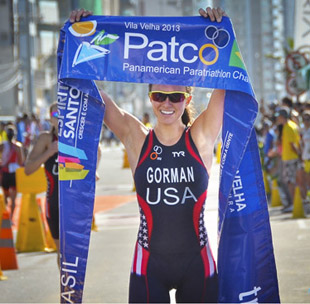
It takes an extended village to raise an elite triathlete. Tamara Gorman gives major credit to her supportive parents and the inspiration she derived from training with her brother Brian and Tony. But much credit also goes to Jenny Weber and USA Triathlon. “The biggest difference in lifting me to junior elite status has been USA Triathlon,” she says. “But I also think my swim team and all my cross country and track coaches in Rapid City really made a significant difference.”
She also cites valuable lessons learned from USA Triathlon elites who volunteered to serve as mentors to the next generation. “I look up to Gwen Jorgensen,” said Gorman. “I met her when I went to the Olympic Training Center in Colorado Springs last November for a camp and I’ve had a few small chats with her.” Gorman said she learned “a ton” from Jorgensen and the two-time World Triathlon Series winner has kept in touch. “I’ve emailed Gwen a little bit and any questions I have she replies quickly,” said Gorman.
Weber said a key to the rise of these Rapid City triathletes was an unusually strong camaraderie. “Although Tony and Tamara went to different high schools, they forged friendships and grew up on the same swim team – with Tamara’s brother Brian (who swims for the University of Minnesota and also competes in triathlon) as the third musketeer. They are all highly skilled athletes who motivated one another in a healthy way. They support one another, love one another and hold one another accountable. They compete hard and congratulate one another on their successes. That kind of camaraderie and level of commitment is unique and powerful.”
Two years older than Tamara, Tony developed his strongest coaching relationship with University of Michigan cross country coach and assistant track coach Alex Gibby. Gibby is relatively unique among NCAA Division 1 running coaches in that he welcomed and encouraged Smoragiewicz’s parallel interest in triathlon. “One of the main reasons I went there was that coach Alex Gibby allowed me to do cross training,” says Tony. “Most coaches won’t let you train for swimming or biking or triathlons while you are competing at the university in running. So I get in swim workouts with the team coached by Richard Bishop.”
Gibby says that Smoragiewicz’ triathlon prowess is all part of the picture that made him a desirable addition to the Wolverines strong running program. “Tony was an exceptional prospect,” said Gibby. “He was recruited because he was a promising distance runner and an outstanding student who would be a good fit with the academic and athletic rigor at Michigan. We saw him as a good collegiate distance runner and we were happy to allow that to serve as a launch pad to become a world class triathlete.”
Gibby carefully guided Smoragiewicz through a physical setback that hindered his freshman performances. “Tony is still in a raw stage considering the fact that his performances last calendar year since April were masked by issues with iron deficiency which caused significant trouble with endurance performance,” said Gibby. The iron deficiency might have been responsible for Tony’s sub-par performance at the 2012 ITU junior elite World Championships in Auckland after his podium finish the year before.
“Tony was a half-step away from making the NCAA regionals as a red shirt freshman,” said Gibby. “A lot of his performances were masked by iron deficiency, and I sense his best days are ahead and depend on getting more iron in his blood. He made some progress on this front, and I believe he will be a big impact guy when he fully recovers.”

Love of South Dakota
Tony has a deep appreciation for his home territory and has used it to forge his fitness. “It is right on the edge of the Black Hills and it is an awesome place to train. There are great trails for mountain biking and paved roads for road cycling.” Rapid City is 3,200 feet above sea level and Tony often rides to the highest road which tops out at 6,500 feet.
Smoragiewicz says the geographical assets of Rapid City are matched by the character of the people who live there. “I am really happy I am from Rapid City,” he said. “It really shaped my character. It is really health oriented, it has clean lakes and rivers and clean air and the good Midwest people here are really focused on working hard.”
Michigan coach Alex Gibby saw the same things in the place and the people that Smoragiewicz values. “When I visited, Rapid City was absolutely beautiful,” said Gibby. “One of the key things I saw – he has two very good parents. Certainly they love him, but they have not always been easy on him. They are high achievers and hard workers who exemplify those qualities and passed them down to Tony. The environment in Rapid City is a supportive one, with the track teams, the swim club. All his experiences in athletics in Rapid City have been positive.”
Jenny Weber says that the old-fashioned values to be found in Rapid City are key to Tamara and Tony’s success. “Americans are finding life is a little too easy for many of us,” she says. “Nothing is in the water in Rapid City per se. But I know people there are hard workers, humble people and that goes a long ways when added to some inherent talent.”
Tony and Tamara have also gained a lot by training together at home in Rapid City in the summer. “There are so many great places to train around here,” said Tamara. “I love running in the hills and around the lakes.”
Because equivalent talent is hard to find – this summer Tamara’s brother Brian is training in Minnesota – Tony and Tamara do much of their training together. “Sometimes Tony’s dad is along too,” she says. “He leads us in a boat when we do open water swimming in the lakes.” That swim training has particularly paid off for Tony. “This was the first year that I could out split her in the swim,” he said.
Tamara says she is inspired by Tony. “I look up to him so much,” she says.
When asked what she thinks about two Rapid City athletes being the Pan American champion junior triathletes, Tamara is as amazed as anyone. “I really can’t wrap my mind around it because it is such a low probability of happening,” she said. “Our coaches say we are like the Brownlee brothers. And I guess Tony and I are unofficial brother and sister.”
The next step
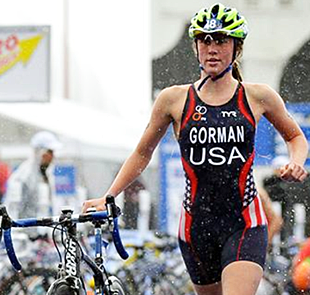
The Rapid City duo will be competing at the USA Triathlon National junior elite championships this weekend in West Chester, Ohio and at the ITU junior elite World Championships September 12 in London. Tony and Tamara are aiming at improving on last year’s silver medals at the US junior elite Championships [Tony finished 7 seconds back of the winner Luke Farkas and Tamara was 9 seconds back of junior women’s winner Breanna Hemming. Farkas and Hemming have both aged up, so Gorman and Smoragiewicz are the pre-race favorites]. Tony and Tamaara are both junior elite World Championship medalists, earning bronze in 2011 and 2012 respectively at Beijing and Auckland.
Looking beyond their dynamic double gold at the Pan American Championships in Brazil, how good can they be when they graduate to the Under 23 and eventually to the senior elite ranks where Olympic medalists await?
Tony by the numbers
Tony will have it improve his swim, which was 17 seconds off the best junior elite swimmer in Brazil and 40 seconds behind Lukas Verzbicas at the Beijing Junior Worlds in 2011. On the bike, he is in the game – the best of a tight pack of leaders at Brazil this year, and 2nd best at the 2011 Grand Final in Beijing. In draft-legal racing, he has been as fast as necessary to stay with the lead pack.
But the best indicator of his future is to compare his runs with Verzbicas, who has already won a World Cup. At Beijing in 2011, Tony was 2 seconds faster than Verzbicas – after giving away 40 seconds on the swim. At Edmonton in 2011, Smoragiewicz was 24 seconds behind Verzbicas on the run and 15 seconds back of his rival at the finish. At the 2011 Junior North American Championships in Clermont, his 14:52 run split was 19 seconds faster than the next best. Comparing all-out 5ks, Tony’s 5,000 meters PR is 14:17, Verzbicas’ high school best was 14:06. In high school, Tony’s best mile was 4:12, Verzbicas broke 4 minutes.
The silver lining? Smoragiewicz has been held back by his iron deficiency and still set a 10k best of 31:00 flat at Michigan. If all goes well and he stays healthy, he could be running a sub-30 minute 10k in a few years – a necessity if he is to achieve draft-legal ITU stardom against the likes of the Brownlees and Gomez.
Tamara on the clock
Gorman’s ace is her swim, which was race-best by a few seconds at the Pan American Championship in Brazil, but 49 seconds better than the winner at the 2012 Junior Elite Grand Final in Auckland, where she finished 3rd. On the bike at Auckland, she gave away 28 seconds to fellow American and eventual 2nd place finisher Stephanie Jenks. On the run at the Grand Final, she gave back 45 and 54 seconds on the bike split to her nearest pursuers. So far, at age 17, she is up and down on the run. She held her lead but gave back 28 seconds to runner-up Jenks on the run in Brazil. At the 2012 junior elite worlds in Auckland, her 17:32 5k was just 4 seconds off the gold medalist’s split. Her high school 17:44 PR at the 5k distance is 1 minute off one of the best runners in the sport – Kelly Williamson’s fastest listed road 5k is 16:45.
The silver lining is that Gorman is just 17, has had a smooth improvement curve, and is within range of the best in the sport at her age in the swim and the run.
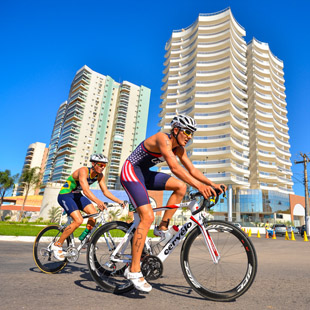
No limits
While numbers give an indication, they cannot predict greatness. Tony’s and Tamara’s coaches both shy away from the numbers game.
“I do not want to put a limit with these two athletes of enormous potential in running, triathlon and life,” says Weber. “I’d hate to set any limits on any of them. So far they have no limit.”
Alex Gibby agrees with Weber. “I always stay away from absolutes,” he says. “I emphasize process, process, process. If I put a number on it, becomes a concrete marker. If the athlete does not make it, it’s discouraging. And sometimes markers become artificial restraints to potential progress. Case in point I had an All American who started at 14:25 for the 5000 and two years later ended up running 13:44. Did I think he could run that range? Yes. If you asked me going into that second season would I be happy if he ran 13:54? Yes. But as a coach I do not want to push my own expectations on athletes. It is an artificial influence and not the best one. Stick with process, you get a lot more.”


